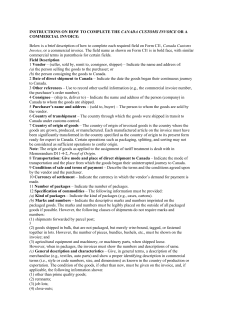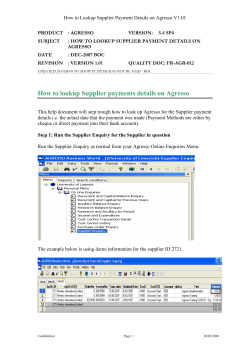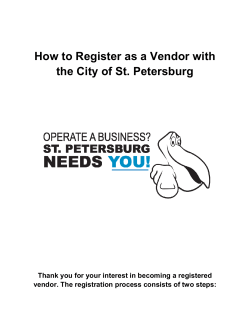
How to maximise supplier relations – and cash flow September 2012
How to maximise supplier relations – and cash flow An m-hance white paper September 2012 How to maximise supplier relations – and cash flow ❘ September 2012 Summary The way that a company manages its accounts payable (AP) process has a bearing on two critical areas that affect the business as a whole: cash flow and supplier relationships. These two factors become increasingly important to the future profitability of an organisation in a difficult economic climate such as that being experienced today. Optimising both demands holistic insight across a company’s finance operations. Integrating and automating key processes, especially those which affect accounts payable, not only gives the business greater leverage in commanding better deals with suppliers while allowing it to maintain cash flow at an optimum level; it also facilitates all sorts of internal efficiencies, driving down operational costs. A company with smooth-running, streamlined AP operations is able to save money by processing invoices with a minimum amount of intervention and with a low cost of materials, for example. For those with responsibility over the finance function, costly problems can arise when the AP process is handled manually. These include: • Exposure to human resource issues, resulting from employee absence and the need for holiday cover • Duplication of effort (paper pushing, duplicate invoice payments and so on) • Spiralling costs associated with physically handling paper and third-party storage fees • The inability to easily access and share documents as needed • The detrimental reputation of the business and the finance team if issues arising cannot be readily resolved The following white paper considers the potential impact of inefficient, manual or only partially automated processes, before setting out the various ‘end-to-end’ technology solutions that enable busy finance departments to secure greater control over their purchase-to-pay (P2P) / accounts payable (AP) processes, allowing them to pass on the benefits to the broader business. The importance of the AP function and the need to move with the times Behind every thriving business is an efficient finance function, deftly managing cash flow and oiling the supply chain with timely payments - so that vital sources of supporting products and services never dry up. Achieving this slickness of operation does not happen by accident. It requires a careful balancing act - on the one hand ensuring that key suppliers are paid on time so that lines of supply keep flowing and suppliers will agree to favourable terms, and on the other that cash reserves are maintained. Without optimised cash flow, even the most prosperous-seeming business can soon run into difficulty. 2 All too often however, businesses underestimate what a fragile situation they would be in without tight cash flow management. In pursuit of growth it is more usual for companies to focus on how much money they are going to make and how they will attack new markets. Yet in their preoccupation with wealth in the form of top-line performance, they lose sight of the day-to-day health of the business: the cash flow situation, which gives a company its flexibility and its ability to meet its existing obligations - and its promises. Traditionally conservative in outlook and often preferring the apparent reliability of methodical manual processes, the finance department is often the last area of a company to consider or be considered for technology investment. Respected observers including IBM, Gartner and Aberdeen Group estimate that some 75-80% of invoices are still processed manually. Seen as a back-office/administrative function and therefore a cost centre, finance is commonly taken for granted – until something goes wrong. And at that point the results could be catastrophic, even closing down the business if cash flow - and lines of credit – falter. A good cash position creates options With the recession showing no signs of abating, and banks’ lending terms allowing little room for manoeuvre, companies neglect their finance department at their peril. A new SME Risk Index undertaken by YouGov on behalf of global insurer Zurich (August 2012) suggests that more than one in 10 British SMEs have recently considered closing down in the face of continuing financial difficulty and concern about the future. At the other end of the spectrum, other businesses are anxious to convert their inertia of recent years into preparing for new economic growth when it eventually comes. New research cited in an article in EN for Business, a magazine for entrepreneurs and SMEs, suggests that small and mediumsized enterprises plan to invest £74.9bn in capital expenditure over the coming 12 months. The findings, from GE Capital, indicate that 92% of businesses are planning an average outlay of £73,805 on commercial vehicles, manufacturing equipment, IT and company cars. Yet without adequate working capital, companies will find it hard to achieve the leverage they need to go after new business without jeopardising the business-as-usual. Shoring up dayto-day cash flow should be a priority for any commercial organisation, before they consider plans to tie up funds anywhere else. This in turn means being prepared to look at new IT systems which can integrate and streamline everyday processes, and provide new visibility into the company’s cash flow status - as well as early alerts to potential problems that may be looming. Streamlining accounts payable processes is the obvious way to start, giving the finance department a tighter handle on the money going out of the business and improving supplier relationships and the leverage the company has when negotiating discounts. Optimised purchase-topay solutions are designed for exactly this purpose, enabling companies to improve business relations with suppliers so that a reliable supply chain is assured and that the business takes full advantage of early payment discounts and other ‘preferred customer’ privileges. Additional benefits can then be derived from close integration with peripheral systems, to further accelerate processes and provide a more rounded view of how one aspect of financial management – and one source of cash flow or cash consumption - affects another. Slicker processes provide a better first impression Without appropriate technology to manage AP processes and track cash flow, finance departments risk not only supplier relations, additional 3 How to maximise supplier relations – and cash flow ❘ September 2012 costs (in the form of full pricing and interest on late payments), and cash flow bottlenecks, but also internal efficiency. Heavy reliance on manual processes by experienced staff increases a company’s exposure to productivity dips through employee absence and the learning curve as new team members are brought up to speed. It also leads to excessive resource consumption, made worse by paperwork duplication, the inability to track down the right documentation quickly, and the need to physically store it all. Not to mention the risk of anything happening to those physical documents - for example, in the event of a fire. Any slowdown in workflow, or emergence of bottlenecks as particular documentation is being tracked down, doesn’t reflect well on the finance team either – or on the credibility of the business. Inefficient manual processes and susceptibility to human error give out the wrong messages to staff, suppliers and customers. Surprisingly - given all of these potential risks (and the substantial potential for increased efficiency and accuracy if processes are automated and visibility boosted by intuitive reporting) – the finance departments of the majority of SMEs still rely far too heavily on manual processes, and paper. Profits: In one door, out through another Commonly, excessive focus on bringing new money in to a company will have resulted in the channelling of IT investment funding to the front-end of the business - in pursuit 4 of new markets and new sales. Yet unless systems are in place to maximise how far those new gains go for the business, companies are inadvertently risking their profits by failing to maximise the company’s cash flow position and take advantage of preferential supplier terms. The more integrated a company’s finance management activities are, for example with payroll systems, the greater visibility its managers will have over its cash flow situation at any given time. Armed with this knowledge, they can take pre-emptive steps to maintain and strengthen this position, ensuring that the business can continue to pursue its goals, without risking the day-to-day health of the company – ie its ability to pay suppliers and staff. That so many SMEs still hold on to archaic manual processes, then, is staggering. When it is considered that UK NHS hospitals, which are stretched to the limit financially, are keenly adopting electronic document management technologies so that they can manage patient records electronically, it seems absurd that commercial businesses still cling on to cumbersome, inefficient and risky paper-based processes. More than two decades on from the first murmurings about the merits of the paperless office, a recent survey has shown that up to 67% of accounts payable departments are still bound by physical documents, which they continue to push around inefficiently and compress into metal filing cabinets. The broader impact of inefficient AP processes If a supplier’s bills are not paid on time, or are consistently riddled with errors, this valued source of products or services to the business may become reluctant to continue to offer lines of credit, or to prioritise their account, because this could have a negative impact on their own bottom line and cash flow. The imminent EU Late Payment Directive seeks to reduce the burden of overdue payments on businesses, by giving companies the right to insist on 30-day payment terms - and to levy penalties and interest on overdue payments. It is hoped that this move will provide the catalyst needed to drive changes in payment practice once and for all. Certainly, businesses will need improved visibility and control over their payment processes to avoid incurring the resulting penalties, and to build their reputation and status as a preferred business partner. To ensure that payment systems and processes are fit for purpose, companies need to reassert control of their purchase-to-pay processes, and integrate processes and systems as far as possible to improve visibility and be able to follow through the implications of any one decision or action. This then gives the financial management choices about how and when to pay, in accordance with the expectations of suppliers and their own working capital strategies. Contrast this situation with more adhoc ‘fire-fighting’, as the finance team reacts to new requests and situations, and it’s easy to see where efficiencies can be gained and the robustness of decisions improved. A research report issued by Proactis a couple of years ago concluded that inefficient AP practices were having a significant and tangible effect on businesses. The chief financial officers surveyed concurred that their business performance was being compromised by ‘underperforming’ accounts payable departments, resulting in higher transaction costs and difficulties in managing working capital. Additional findings suggest that 15% of an organisation’s revenue is spent on creating, managing and distributing documents – with an average document being printed five times. By automating their AP processes, organisations can save significantly on these costs. For many organisations today, particularly SMEs, long-term survival is unlikely to be possible without streamlined and robust AP processes in place. Technology that can be deployed to improve AP efficiency Implementing process improvements and new technology empowers a company to proactively manage its accounts payable activities with multiple goals in mind: • To pay invoices on a predetermined schedule of the company’s choosing • To ensure the accuracy and authenticity of invoices that the company pays • To minimise, or eliminate paper • To extract key business metrics • To effectively manage working capital 5 How to maximise supplier relations – and cash flow ❘ September 2012 Typically 80% of the accounts payable function is associated with invoice processing. However, despite 99.9% of all invoices being prepared electronically, the vast majority are processed by manually keying information from a paper invoice document into an automated system to then process and pay! This represents a considerable waste of time and effort, especially given that the reproduction process can lead to the introduction of inaccuracies. Automating the function not only eliminates these risks, but enables the digitised content to be re-used in a number of efficient and intelligent ways, improving managerial visibility, accelerating processing, improving reliability, sharpening internal financial controls and optimising a company’s most critical asset (other than its people): CASH. A case in point: The Russell Group in Scotland The Russell Group ( http://www.johngrussell.co.uk/ ), Scotland’s leading logistics and warehousing group, reports efficiency savings of £100,000 per year as a result of automating its purchase-topay process with a comprehensive, end-to-end electronic invoice solution that encompasses approvals and accruals. Previously, the group’s purchaseto-pay processes were highly timeconsuming and costly due to handling large volumes of paper. Purchase invoices coming in to the head office in Glasgow would have to be circulated to 15 different sites across the UK for signatory approval. Often, invoices would go astray, resulting in further delays to the approval process. 6 The Russell Group estimated that it was taking around four weeks from distributing an invoice to the relevant person, to having it manually authorised and returned to the finance department for processing. As the organisation grew, the inefficiencies were magnified with inordinate amounts of time spent chasing people for approval. The lack of visibility about where invoices were in the approval chain also had an impact on the control the group had over its finances, and on crucial supplier relationships. As a result of tightly integrating the new e-invoicing solution tightly with the group’s finance system, the 75,000 invoices that the Russell Group receives each year are now electronically scanned or emailed directly to head office. The system accurately tracks the status and location of all unapproved invoices using the finance system’s query tool, speeding up the group’s entire approval process and vastly reducing the amount of wasted time associated with lost or missing documents. Powerful invoice-matching workflow, meanwhile, provides added functionality for users to approve, reject or query scanned invoices via a simple web browser. This functionality also incorporates enquiries for entering and approving requisitions in addition to checking and approving invoices that have been marked as requiring approval, improving financial visibility and accounts payable reporting. Having automated a range of paperbased processes using the new web-based solution, the Russell Group claims it is saving in excess of £100,000 each year, while having greater financial control. Invoice approval times have shrunk from four weeks to just 10 minutes, transforming staff productivity levels. A further benefit is that, by being able to pay invoices in a timelier manner, the group has boosted its supplier relationships, putting it in a stronger position to negotiate early payment discounts. E-invoicing: Eliminating paper wherever possible To further streamline and drive AP efficiency, it is recommended that organisations implement document management and e-invoicing solutions and in such a way that they are tightly integrated into the company’s ERP purchase-to-pay solution. Today there is really no excuse to be issuing, handling or re-keying information from paper invoices when everything could be so efficiently and easily managed electronically with all of the associated benefits of being able to spontaneously search and call up related documentation, and to access and share this with remote colleagues, suppliers or clients as appropriate. The now widespread acceptance of cloud-based software and services makes it easier than ever to deploy such capabilities, safe in the knowledge that the content has been reliably backed up, and that it can be viewed securely from anywhere by anyone with the appropriate access rights. Barriers to change So why aren’t more companies taking advantage? A 2012 survey of financial directors from more than 600 companies by Tradeshift provides some clues. The research, which looked at barriers to adoption, found that for many companies up to 48% of invoices still had to be scanned or input manually, due to the inaccuracy of optical character recognitionbased scanning (OCR). Sometimes the technology fails to interpret invoice data correctly – confusing a ‘0’ with an ‘o’, for example. Interestingly, 57% of FDs participating in the research admitted that e-invoicing would be more widespread if it was free to all suppliers. Fortunately, a new generation of cloudbased technology offers to address many, if not all, of these concerns. Unlike traditional e-invoicing systems which still rely on a certain amount of manual intervention, cloud-based e-invoicing solutions completely remove the need to ever print off, scan or manually handle paper. They are able to process text PDF invoices sent by email, by automatically extracting data from the PDF itself via a cloud service application. This data is then converted into a standard electronic invoice format before it is uploaded into an organisation’s finance system. In addition, unlike OCR, cloud e-invoicing solutions are 100% accurate as they do not rely on ‘interpretation’. Evidence suggests that a company processing more than 5,000 invoices per year could save between 6080% of their existing processing costs by switching to a cloud-based e-invoicing solution. This could translate to something in the region of £30,000 to £350,000 depending on the volume of invoices processed over a three-year period. 7 How to maximise supplier relations – and cash flow ❘ September 2012 What’s more, new cloud-based invoicing solutions don’t cost anything for suppliers, which is a big step in the right direction if e-invoicing is to enter the mainstream and fulfil its promise of revolutionising financial and business efficiency. Streamlining purchasing to further improve AP efficiency For maximum improvements to internal processes and cash flow, organisations should be looking to multiply the benefits wherever possible - by feeding the efficiency gains achieving through one system into improvements to another, to create a situation where two plus two adds up to a lot more than four. For a more holistic transformation, businesses would be advised to look to implement an end-to-end purchase-to-pay solution that is tightly integrated with the company’s ERP system. One cost-efficient approach, with the potential for significant impact, is to harness a webbased e-procurement solution with electronic workflow functionality. This offers a company the ability to track and efficiently manage everything from recording a requisition, sending it through the approval process, and/ or receiving an invoice and entering it onto an organisation’s finance system for approval, to making the accruals at the period end. Such an approach offers the added benefit of being able to track the approval process through the finance system’s reporting tools, significantly adding value to the AP function. Organisations that have drawn on this broader kind of solution have 8 been found to benefit from around a 50% reduction in the overall cost of processing, from receipt of paper invoice to payment. In the optimum scenario the end-to-end process also registers and monitors the online receipt of goods (automatically alerting the finance team to enter the invoice onto the finance system and electronically circulate for approval); ensure automatic holiday provision (to ensure invoices can be assigned to a colleague to approve); and provide a facility for budget checking and recording of historical requisitions (to avoid re-keying of information). Approach accounts payable and its supporting activities in a holistic way like this and the advantages soon multiply. Key benefits now include: - Greater financial control – for example, through the elimination of ‘maverick’ spending - The ability to maintain an effective invoice register through the finance system to enhance accounts payable reports - The ability to maintain historic records of approvals, detailing an audit trail of the approval process (ie greater financial transparency) - An end to lost or mislaid paperwork which can cause troublesome not to mention embarrassing delays in making payments, while potentially incurring late payment charges - 50% reduction in the overall cost of processing from receipt of paper invoice to payment Conclusion It is all too easy for a business to neglect its finance department when looking for savings and transformation through IT. Yet companies that do this could be undermining the profits coming into the business, not to mention their future leverage when it comes to preparing for and investing in new growth. Just as it is a false economy to pursue new business at the expense of keeping existing customers satisfied (given the relative cost of sale), prioritising revenue generation and business expansion over a company’s cash position is a risky strategy. For many companies, modernising the vital supporting activities of the finance department is long overdue. The good news is that the latest solutions, particularly those which harness web-based portal features and cloud-based delivery, are easy and cost-effective to deploy - and offer additional business benefits beyond those associated with the automation of manual processes. These include the ability to share content remotely, get invoices approved when signatories are out and about, and trigger alerts when bottlenecks to workflow are threatened or when cash flow risks being compromised. For the sake of the company’s reputation alone, organisations should be looking to dispense with paper and secure a tighter handle on their documentation so they can address queries satisfactorily in a single phone call or email. For the sake of the ongoing fortunes of the business, they should be building a bigger picture of their financial leverage, maximising the company’s ability to invest when banks aren’t lending, and staying the right side of suppliers – especially with new 30-day payment rights coming into force. Their survival and future prospects may depend on it. 9 How to maximise supplier relations – and cash flow ❘ September 2012 Source & resources Five reasons to automate your AP processes, Accounts Payable News: http://www.accountspayablenews.org/apautomation/reasons-to-automate/191-five-reasonsto-automate-your-ap-processes.html SMEs for prepare for growth, EN Magazine: http://www.enforbusiness.com/news/smes-preparegrowth-20116369 Business process management, Accounts Payable News: http://www.accountspayablenews.org/apautomation/business-process-management-.html One in 10 British SMEs has considered closing down, British SME: http://www.britishsme.co.uk/2012/08/15/one-inten-british-smes-has-considered-closing-down The Necessities of Paperless Accounting Systems, American Journal of Scientific Research ISSN 1450223X Issue 7 (2010), pp.106-118, © EuroJournals Publishing, Inc. 2010: http://www.eurojournals.com/ajsr_7_09.pdf If AP fails, business fails, Accounts Payable News: http://www.accountspayablenews.org/apautomation/e-invoicing/70-cash-flow.html PROACTIS Survey Finds Inefficiencies in Accounts Payable: http://www.eclgrp.com/news/proactis-survey-findsinefficiencies-in-accounts-payable SMEs battle outstanding invoices, Accounts Payable News: http://www.accountspayablenews.org/payments/89survival-of-the-fittest.html Who’s in charge of cash flow, Bilbus Blog: http://blog.bilbus.com/tag/sanjeev-chhuganiworking-capital-small-business-financing-financialtechnology-commercial-finance-alternative-financing Dynamic discounting, Accounts Payable News: http://www.accountspayablenews.org/payments/366dynamic-discounts-join-the-revolution.html 10 Reasons to automate, Accounts Payable News: http://www.accountspayablenews.org/apautomation/reasons-to-automate.html Terms of Endearment: Avoiding Late Payment Penalties, Accounts Payable News: http://www.accountspayablenews.org/payments/353terms-of-endearment-avoiding-late-paymentpenalties.html A guide to invoicing, The Guardian Small Business Network: http://www.guardian.co.uk/small-businessnetwork/2012/aug/03/how-to-invoice-best-of EU Late Payment Directive: http://ec.europa.eu/enterprise/policies/singlemarket-goods/fighting-late-payments/index_en.htm E-invoicing benefits: http://www.einvoicingbasics.co.uk/benefits-ofeinvoicing Tradeshift e-invoicing survey: http://www.sharedserviceslink.com/file/94414/iseinvoicing-failing-to-deliver.html mha_wp_MCF_0912 How to maximise supplier relations – and cash flow ❘ September 2012 m-hance implements, deploys and manages enterprise wide systems for mid-tier organisations that wish to improve operational performance. We deal with the complexities of delivery and, where appropriate, the management of your business platform. We call this Unifying Business – ensuring that the right information is harnessed from the right systems to support the right outcomes. A Microsoft Gold Partner, m-hance has, over many years, demonstrated a capability to implement solutions effectively. We can deploy on premise, through managed services or via the cloud. We have over 800 customers and 150 staff based in a network of regional UK offices. m-hance ltd. Registered in England, No 01369937 Registered office Trinity House, Bredbury Park Way, Stockport, SK6 2SN Tel: +44 (0)161 406 2300 • Email: info@m-hance.com • www.m-hance.com © m-hance ltd 2012
© Copyright 2025


















